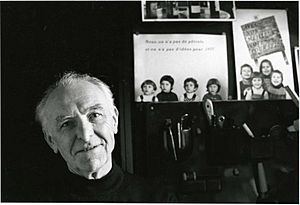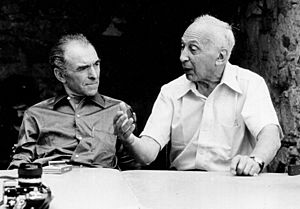Robert Doisneau facts for kids
Quick facts for kids
Robert Doisneau
|
|
|---|---|

Doisneau in his studio in Montrouge, 1992
|
|
| Born |
Robert Doisneau
14 April 1912 Gentilly, Val-de-Marne, France
|
| Died | 1 April 1994 (aged 81) Montrouge, France
|
| Resting place | Raizeux |
| Education | École Estienne, 1929 graduate, diplomas in engraving and lithography |
| Occupation | Photographer, engraver |
| Known for | Street photography, Le baiser de l'hôtel de ville (The kiss by the City Hall) |
| Title | Chevalier of the Order of the Legion of Honour |
Robert Doisneau (born April 14, 1912 – died April 1, 1994) was a famous French photographer. Starting in the 1930s, he took many pictures of the streets of Paris. He was a big supporter of what is called humanist photography, which focuses on people and their everyday lives. Along with Henri Cartier-Bresson, he was also a pioneer in photojournalism, which means telling stories through photographs.
Doisneau is especially well-known for his 1950 photograph called Le baiser de l'hôtel de ville (which means The Kiss by the City Hall). This picture shows a couple kissing on a busy street in Paris.
In 1984, the French president, François Mitterrand, made him a Chevalier (Knight) of the Legion of Honour. This is a very important award in France.
Contents
Capturing Life: Robert Doisneau's Photography Career
Doisneau is remembered for his simple, fun, and sometimes funny pictures. He often showed interesting mixes of people from different social classes and unique characters on the streets and in cafes of Paris. He was inspired by other photographers like André Kertész and Henri Cartier-Bresson. In his many photography books, he shared a charming view of human life and its quiet, sometimes unexpected, moments.
Doisneau's work often highlighted children's street culture in a special way. He frequently photographed children playing in the city, free from their parents' watchful eyes. He treated their games with seriousness and respect, showing how important play was to them.
Early Life and Artistic Beginnings
Robert Doisneau's father, who was a plumber, died in World War I when Robert was about four years old. His mother passed away when he was seven. After that, his aunt raised him.
When he was 13, he went to the École Estienne, a special craft school. He graduated in 1929 with skills in engraving (making designs on metal or wood) and lithography (a type of printing). This is where he first learned about art, taking classes in drawing people and still life (pictures of objects).
At 16, he started taking photos as a hobby. He was very shy, so he began by photographing cobblestones before moving on to children and then adults.
In the late 1920s, Doisneau worked as a draughtsman (someone who draws plans or designs) for an advertising company called Atelier Ullmann. This company made graphics for the pharmaceutical industry. Here, he found a chance to change his career by also helping out as a camera assistant and then becoming a full-time photographer for the studio.
Photography in the 1930s: From Studio to Streets
In 1931, Doisneau left the advertising studio and started working as an assistant for the modern photographer André Vigneau. In 1932, he sold his first photo story to Excelsior magazine.
In 1934, he began working as an industrial photographer for the Renault car factory in Boulogne-Billancourt. Working at Renault made Doisneau even more interested in photographing people. However, he was often late, and after five years, in 1939, he was fired.
This led him to work as a freelance photographer, taking pictures for advertising, engravings, and postcards to make a living. At that time, France made the most postcards in Europe, and they were used for greetings and souvenirs. In 1991, he said that his time at the Renault factory was "the beginning of his career as a photographer and the end of his youth."
Later in 1939, he was hired by Charles Rado of the Rapho photographic agency. He traveled all over France looking for interesting stories to photograph. This is when he started taking his first professional street photographs.
War Service and Post-War Photography
Doisneau worked for the Rapho agency until World War II began. He then joined the French army as both a soldier and a photographer. He served until 1940. From then until the war ended in 1945, he used his drawing and engraving skills to create fake passports and ID papers for the French Resistance, a group fighting against the occupation.

Some of Doisneau's most famous photographs were taken after the war. He went back to being a freelance photographer and sold his pictures to magazines like Life and other international publications. He briefly joined another agency but returned to Rapho in 1946 and stayed with them for the rest of his career. He even turned down an offer from Henri Cartier-Bresson to join the famous Magnum Photos agency.
Doisneau's photographs never made fun of the people in them. For example, he refused to photograph women whose heads were shaved as punishment after the war.
In 1948, Vogue magazine hired him as a fashion photographer. The editors thought he would bring a fresh, more relaxed style to the magazine. However, Doisneau didn't really enjoy photographing beautiful women in fancy settings. He much preferred taking pictures on the streets of Paris. Whenever he could leave the studio, he would go out and photograph city life.
The 1950s were a very successful time for Doisneau. In the 1970s, as Europe changed and television became more popular, old-style picture magazines started to close. Doisneau kept working, creating children's books, advertising photos, and portraits of famous people like Alberto Giacometti and Pablo Picasso.
Doisneau also worked with writers and poets, including Jacques Prévert. He said that Prévert helped him feel confident enough to photograph the everyday street scenes that most people usually didn't notice.
Since his death in 1994, Doisneau's photography has become very popular again. Many of his portraits and pictures of Paris from after World War II through the 1950s are now used on calendars and postcards, becoming symbols of French life.
The Kiss by the City Hall: A Famous Photograph
In 1950, Doisneau created his most famous work for Life magazine: Le Baiser de l'hôtel de ville (The Kiss by the City Hall). This photograph shows a couple kissing on a busy street in Paris and became a worldwide symbol of young love in the city. For many years, no one knew who the couple in the picture was.
In 1992, a couple named Jean and Denise Lavergne mistakenly thought they were the people in The Kiss. When Robert Doisneau and his daughter Annette met them, he didn't want to disappoint them, so he didn't say anything. This led to the Lavergnes taking him to court, saying he took their picture without their permission. In France, people own the rights to their own image.
Because of the court case, Doisneau had to reveal the truth. He explained that he had asked two young actors, Françoise Delbart and Jacques Carteaud, to pose for the picture. He had seen them kissing earlier but hadn't photographed them because he was shy. He approached them and asked if they would kiss again for his camera. Doisneau won the court case against the Lavergnes. In 1992, Doisneau said, "I would never have dared to photograph people like that. Lovers kissing in the street, those couples are rarely legitimate."
The couple in The Kiss were Françoise Delbart, who was 20, and Jacques Carteaud, who was 23. They were both hoping to become actors. In 2005, Françoise Bornet (who was Françoise Delbart) said, "He told us we were charming, and asked if we could kiss again for the camera. We didn't mind. We were used to kissing. We were doing it all the time then, it was delicious. Monsieur Doisneau was adorable, very low key, very relaxed." They posed in a few places in Paris, including the Hôtel de Ville. The photograph was published in Life magazine on June 12, 1950. Françoise and Jacques's relationship lasted for nine months. Françoise continued acting, but Jacques became a wine producer.
In 1950, Françoise Bornet received an original print of the photograph, signed by Doisneau, as payment for her help. In April 2005, she sold this print at an auction for €155,000 (about $180,000 USD at the time) to a collector from Switzerland.
Robert Doisneau's Personal Life
In 1936, Doisneau married Pierrette Chaumaison. He had met her in 1934 when she was cycling through a village where he was on holiday. They had two daughters, Annette (born in 1942) and Francine (born in 1947). From 1979 until his death, Annette worked as his assistant.
His wife, Pierrette, passed away in 1993 after suffering from Alzheimer's disease and Parkinson's disease. Doisneau died six months later in 1994. He had undergone a triple heart bypass and was also suffering from acute pancreatitis. Annette said that the court case about The Kiss deeply upset her father. She felt that "The Kiss ruined the last years of his life" and that he "died of sadness" because of it and his wife's illness.
Doisneau was a shy and humble man, much like his photography. Even when he was very famous, he would still deliver his own work.
He lived in southern Paris for his entire life. He is buried in the cemetery at Raizeux next to his wife.
Awards and Tributes
- Kodak Prize, 1947
- Niépce Prize, 1956 (named after Nicéphore Niépce, an early photography pioneer)
- Grand Prix National de la Photographie, 1983 (a major national photography award)
- Balzac Prize, 1986 (named after the writer Honoré de Balzac)
- Chevalier of the Order of the Legion of Honour, 1984
- Honorary Fellowship (HonFRPS) from the Royal Photographic Society, 1991
- The Maison de la photographie Robert Doisneau in Gentilly, Val-de-Marne, is a photography gallery named in his honor.
- Several primary schools in France are named after him.
- The Allée Robert Doisneau (Robert Doisneau Lane) is named after him in the 'Parc de Billancourt', where the old Renault factory used to be.
- On April 14, 2012, Google celebrated his 100th birthday with a special Google Doodle on their homepage.
Images for kids
-
Doisneau (left) and André Kertész in 1975 at Arles
See also
 In Spanish: Robert Doisneau para niños
In Spanish: Robert Doisneau para niños





